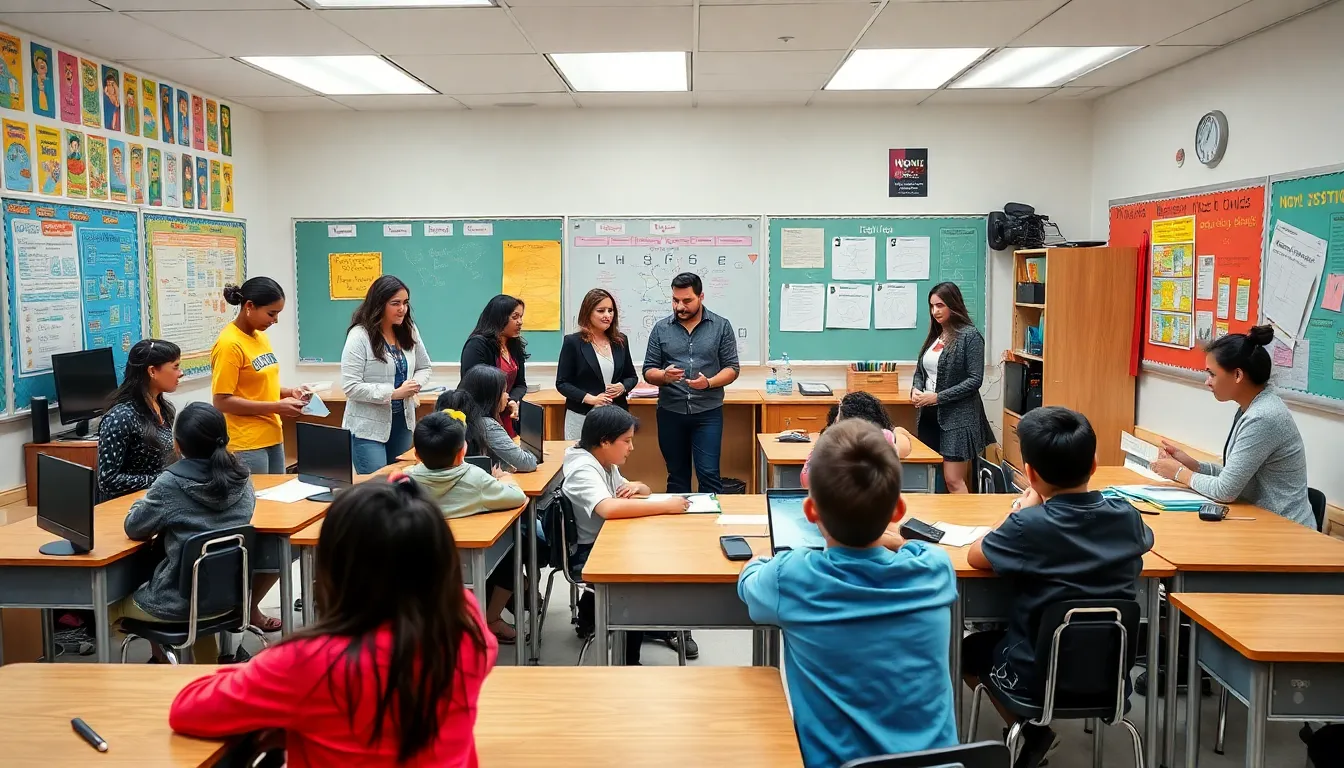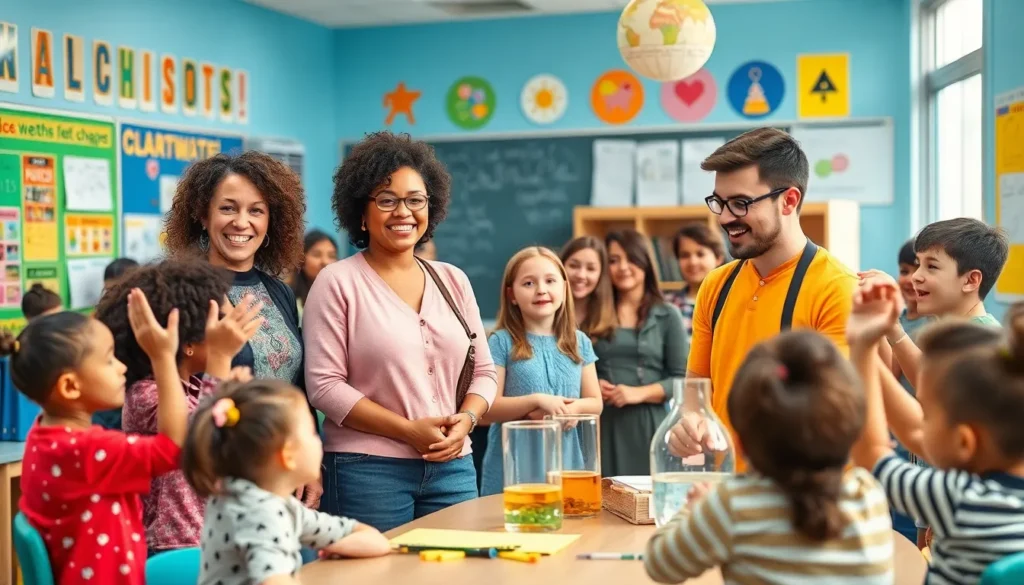Table of Contents
ToggleIn a world filled with endless distractions and TikTok trends, school teachers stand as the unsung heroes, shaping young minds with a blend of knowledge, patience, and a sprinkle of humor. They juggle lesson plans, classroom chaos, and the occasional flying paper airplane, all while making learning feel like an adventure rather than a chore.
Imagine a life without these dedicated educators guiding the next generation. The thought alone is enough to make anyone shudder. From deciphering the mysteries of math to unraveling the complexities of literature, teachers do it all—often armed with nothing but a whiteboard marker and an endless supply of coffee. So, let’s dive into the world of school teachers and explore the incredible impact they have on students, schools, and society as a whole. After all, behind every successful student is a teacher who believed in them—even when they didn’t believe in themselves.
Overview of School Teachers
School teachers play an essential role in education, directly influencing students’ academic and social development. They cultivate critical thinking skills, encourage creativity, and foster a love for learning in diverse classroom settings. Through lesson plans, teachers deliver specific content while adapting their approaches to suit varying student needs.
In many cases, teachers serve as mentors, providing support beyond academic subjects. According to the National Center for Education Statistics, there are over 3.8 million teachers in public schools across the United States. These educators face challenges daily, making innovative solutions crucial for effective teaching.
Patience and resilience characterize their profession, enabling teachers to adapt to classroom dynamics. Many teachers employ humor and engaging activities, transforming traditional learning into enjoyable experiences. This transformative approach helps students connect with lessons, promoting deeper understanding and retention.
Furthermore, teachers often collaborate with parents and school communities to create a supportive environment for students. Various professional development programs allow teachers to enhance their skills and stay updated with educational trends. Continuous improvement strengthens teaching practices and promotes positive outcomes for students.
It’s important to acknowledge that teachers impact not only their students but also the larger community. They inspire future leaders, scientists, and creators by instilling confidence and a strong work ethic. Their commitment to fostering growth empowers students to overcome challenges and achieve success.
Roles and Responsibilities

School teachers play a crucial part in facilitating a positive learning environment. They manage various tasks that contribute to student growth and academic success.
Classroom Management
Classroom management involves creating an organized, respectful atmosphere for all students. Teachers establish rules and routines that promote engagement and minimize disruptions. They actively monitor student behavior, ensuring that each pupil feels valued and included. Utilizing a range of strategies, teachers adapt their approach to suit different learning styles, helping students thrive. Clear communication with students fosters mutual respect, allowing for constructive dialogues. Additionally, incorporating interactive activities keeps students focused and enhances participation. Through consistent enforcement of classroom norms, teachers create a stable foundation that encourages learning.
Curriculum Development
Curriculum development is central to a teacher’s role in guiding student learning. Collaborating with colleagues helps ensure that educational content meets state standards and caters to student needs. Teachers assess learning outcomes to identify gaps and adjust lessons accordingly. Integrating technology into lesson plans provides diverse learning methods and engages students more effectively. They also seek student feedback to refine curriculum materials, making learning more relevant and enjoyable. Professional development opportunities further equip teachers with the latest educational practices, allowing them to create dynamic, impactful lessons. Adapting curriculum based on student interests fosters a more personalized learning experience, driving academic success.
Impact on Student Learning
School teachers significantly influence student learning through various methods and techniques. Their dedication shapes academic success and fosters a positive social environment.
Teaching Methods
Diverse teaching methods enhance engagement and understanding. Interactive discussions promote participation, allowing students to express thoughts. Visual aids reinforce lesson concepts, catering to different learning styles. Group activities encourage collaboration, helping students develop teamwork skills. Teachers often incorporate technology to make lessons relatable and dynamic, creating immersive learning experiences. Personalized instruction targets individual needs, ensuring that all students grasp key concepts.
Assessment Techniques
Assessment techniques play a vital role in tracking student progress. Formative assessments offer immediate feedback, allowing teachers to adjust instruction. Quizzes and tests measure understanding of material, guiding future lessons. Projects showcase creativity and critical thinking, providing insights into student capabilities. Teachers analyze assessment data to identify gaps in knowledge, tailoring interventions as needed. Regular communication with students about performance fosters a growth mindset, encouraging continuous improvement.
Challenges Faced by School Teachers
Teachers often encounter significant challenges while trying to balance their professional responsibilities with personal lives. Managing time efficiently proves difficult due to the demands of lesson planning and grading. Many teachers find themselves working evenings and weekends to keep up, impacting their overall well-being.
Work-Life Balance
Navigating work-life balance remains a crucial challenge for teachers. Juggling administrative tasks alongside classroom responsibilities consumes time and energy. Long hours lead to burnout for many educators, affecting their mental health and productivity. Maintaining personal time becomes difficult when lesson preparation and student needs persistently encroach on after-school hours. Implementing strategies like setting boundaries and prioritizing self-care can alleviate some pressure. Simple practices, like scheduling downtime, may help restore balance.
Professional Development
Professional development represents another challenge. Teachers often seek growth opportunities but frequently face barriers, such as limited access to training resources. Enrichment workshops and conferences may require substantial time commitments that clash with their teaching schedules. Staying current with educational trends and best practices motivates educators, yet inadequate institutional support can hinder progress. Finding online courses or collaborative learning communities can enhance skills while accommodating busy schedules. Investing in professional growth enhances classroom effectiveness, ultimately benefiting student outcomes.
School teachers play an indispensable role in shaping the future. Their unwavering commitment to nurturing students’ academic and social development is evident in every lesson taught and every challenge faced. By fostering a supportive and engaging learning environment they empower students to overcome obstacles and strive for success.
Despite the pressures and challenges of the profession teachers remain dedicated to their craft. Their ability to adapt and innovate ensures that each student receives the attention and encouragement they need. Investing in teachers not only benefits individual students but also strengthens communities and society as a whole. The impact of a great teacher lasts a lifetime and their influence shapes the leaders of tomorrow.




